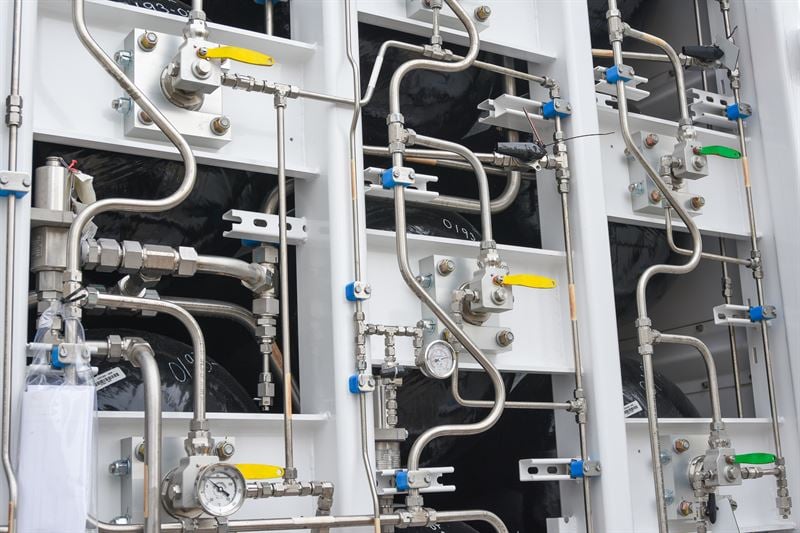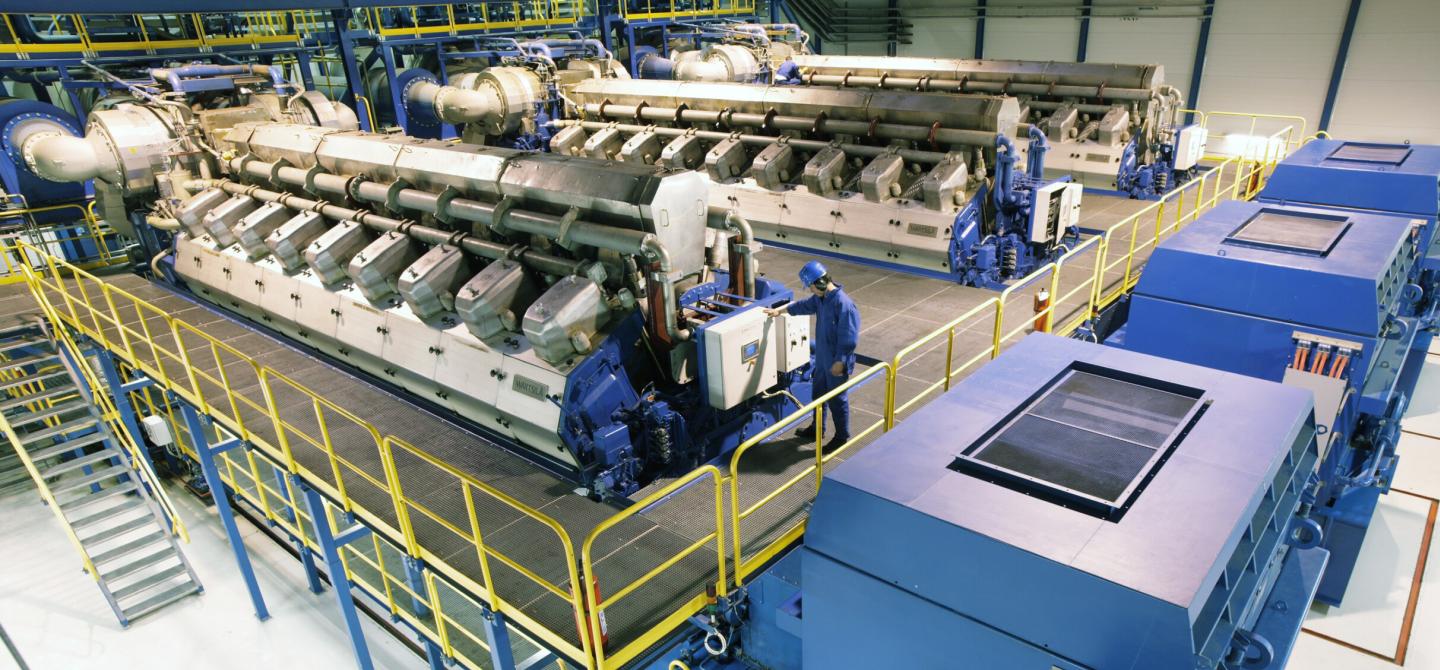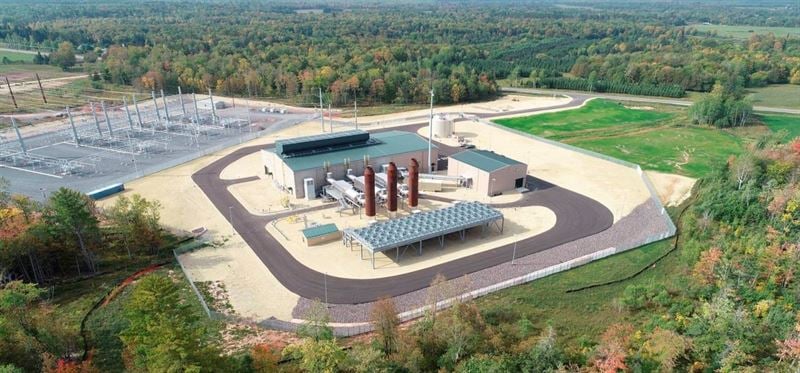Umlauts and hydrogen fuel blends have a lot more in common than you think. Both are attention-grabbing, a bit bizarre, and from a purpose standpoint, downright puzzling to the vast majority of people. But whereas the Germanic vowel enhancement has been around for a hot minute, the alternative option is far more of a modern manmade product. And while large-scale hydrogen fuel (H2) production, refueling station infrastructure, and affordability are still years to decades away from reaching fruition, one thing is for certain, the earth’s fuel sources are evolving…
Recently, advancements in hydrogen fuel development and implementation have been made via bus-sized internal-combustion engines. The focal point of those advancements is the act of sending energy back to the grid via the cleanest methods possible. To do so, companies like European-based Wärtsilä have teamed up with the Electric Power Research Institute (EPRI) and the WEC Energy Group to make massive moves in the hydrogen sector. With the keyword here being massive. Apparently, these firms recently created “…the largest commercially operated engine ever to run on a hydrogen fuel blend, representing a world-first achievement.”
Say Hello to Hydrogen: It’s Gonna Be HUUUUUUUUGE…
When testing of the world’s largest hydrogen combustion engine was first conducted in late 2022, a certain level of skepticism was voiced by engineers and fueling experts alike. Hydrogen blending tests have long been more of a mishmash of vaporware and unimpressive performance results than materialized fueling magic.
However, there’s far more to this recent breakthrough than just a big-ass engine and some futuristic “go-juice.” This test marks the first real-world case where “green hydrogen” was implemented to reduce the carbon footprint of an existing gas-fueled power-generating station. And do you know what? It freakin’ worked.
The results of the testing with a hydrogen/natural gas blended fuel mix have been outstanding. We continue developing and futureproofing our engines to run on sustainable fuels and expect to have an engine and power plant concept for operating with pure hydrogen available by 2026. — Anja Frada, chief operating officer, Wärtsilä Energy
While the full executive summary from EPRI contains a dizzying array of minute details pertaining to the engine experiment itself, we found the summarized version contained within Wärtsilä’s press release to be far more palatable. So without further ado, here’s how the H2 hit the proverbial fan.

The Wärtsilä 50SG is the largest commercially operated flexible balancing engine to ever run on a hydrogen fuel blend, a world-first, and one that holds great promise for the future of net-zero power grid operations the world over. Photo Credit: Wärtsilä Corporation
Meet the Godzilla of Wärtsilä
For those of you who are unfamiliar with Wärtsilä, here are a few fast facts on the monster of a motor it built and used for this little experiment.
Like most energy grid-generating internal combustion engines, the “50SG” is a unit that runs on a four-stroke, spark-ignited gas engine generator set. An engine that when combined in tandem with other units, has the power to keep an entire university campus fully powered around the clock.
While Wärtsilä claims that the powerplant is engineered with “high efficiency in a small footprint” in mind, there’s no getting around the fact that this is one monolithic motor. Measuring nearly 19 meters in length, with a width of just over 5.5 meters, and a height that easily crests 6 meters, this engine is more akin to a locomotive than a motor.
Making the Magic Happen With Hydrogen
According to Wärtsilä, tests began in October 2022 at WEC Energy Group’s 55 MW A.J. Mihm power plant in Michigan. The test mule? The aforementioned 18 MW 50SG engine that, outside of being hooked up to a hydrogen-blending skid from Certarus Ltd., was completely bone stock.
With power pumping to the grid, the capability of the engine to co-fire on a variety of different hydrogen blends was implemented and sternly scrutinized. Improvements in engine efficiency are one thing. But reducing greenhouse gas emissions and remaining in compliance with state and federal NOx emission standards was just as vital to the experiment’s success. In short, the team was walking one hell of a thin tightrope.
With time, it became apparent that a 95-percent engine load was indeed achieved with the 25-volume-percent H2 blend. The fuel flexibility of the 50SG Wärtsilä engine proved that clean combustion and efficiency could be achieved with zero modifications needed.
It may have taken a full three days of continuous testing before Wärtsilä was confident enough to claim that its engine was working on point. But as the quote from EPRI below clearly illustrates, the group effort paid off in spades.
This demonstration project with Wärtsilä and WEC Energy Group is significant in showing the potential of hydrogen blending in natural gas-fired engines. The learnings from this project will be shared with the energy industry to further progress toward deep decarbonization targets. — Neva Espinoza, EPRI vice president of Energy Supply and Low-Carbon Resources
Furthermore, EPRI’s assessment of the engine’s performance during testing showed that a 17-volume-percent H2 blend resulted in a 100-percent engine load. Thus certifying that this class of engine can maintain prolonged higher efficiency ratings when compared to simple-cycle gas turbines, with CO2 output levels being far lower in these systems than in traditional turbine alternatives.
These findings come months after EPRI made waves by confirming that hydrogen could indeed be safely blended with natural gas to power certain Wärtsilä engines. Granted, this was just another trial phase, but one that yielded fruit. Big, juicy, green fruit…

Tests successfully completed, Wärtsilä was able to show that one of its engines did indeed have the capability of safely and efficiently running on a 25-percent-by-volume hydrogen fuel blend. Photo Credit: Wärtsilä Corporation
Hold On… Is Hydrogen the Fuel of the Future?
As the fuel market continues to destabilize, renewable energy appears to be more vital than ever. But if the wind isn’t blowing, the river stops flowing, and the sun is obfuscated by a canopy of clouds, a different kind of alternative power source must be secured. Hydrogen can be used as a form of long-term energy storage, or even as an emergency energy source. All with zero carbon or CO2 being emitted in the process.
Now as for how much of the market relies upon hydrogen in the next few years is anyone’s guess. According to experts, capacity levels could realistically spike from 8 GW per year, to well over 60 GW by 2030. But to do so, hydrogen can’t be the only heavy hitter that’s up to bat.
We’re very pleased to take a leading role in exploring the potential of this technology as we focus on providing customers with affordable, reliable, and clean energy. As we bring more renewable energy online, we must ensure that we can keep the lights on when the sun is not shining and the wind is not blowing. The results of this project are a strong indicator that these dispatchable units can run on very low- and no-carbon fuels. — Gale Klappa, executive chairman, WEC Energy Group
Unfortunately, the global energy industry cannot handle hydrogen suddenly becoming the primary power source for the people. Wärtsilä says that in order to do so, a substantial transition to “…market-ready engines which can run on sustainable fuels is therefore crucial in supporting the transition to net-zero.”
So for now we’ll just have to sit back and see what develops next, as surely this big hydrogen breakthrough is but the tip of the proverbial iceberg. However, it also further proves that even in the rapidly changing energy landscape, internal-combustion engines will have a place in the world.




















